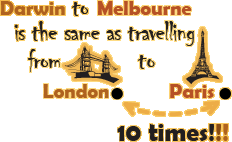Route
Northern Territory
The highway was only fully sealed in the mid-1980s as part of Australia's bicentenary road works programme. There are no police patrolling the majority of this remote highway and before the end of 2006 there was no actual speed limit outside towns and other built-up areas on the Northern Territory part. The bulk of the Northern Territory's population not living in Darwin lies along the Highway. The Northern Territory passed from South Australia to the Federal Government in 1911 and, despite forming its own government in 1978, is still administered from Canberra. A referendum of the people of the Northern Territory held in conjunction with territory elections in 1998 for it to move towards statehood was defeated by a slim majority.
NT is a tropical area that becomes increasingly arid as you head south. The State is very sparsely populated, and is mainly made up of wilderness areas and stations (huge farms). Darwin. It is not a big city by Australian standards, but Darwin is the main gateway to this vast state, and is also the closest city to Asia.
The city is pleasant and has a laid back feel to it. But this city hasn't always been so peaceful. The city has been destroyed and rebuilt twice. In 1945 the Japanese bombed Darwin making this the only Australian city to ever be attacked. The second event was a powerful cyclone on Christmas Day, 1974. While the rest of the world were celebrating Christmas, residents of Darwin were under siege from the most powerful cyclone they have ever experienced. Today it is hard to imagine that such an event took place as the city has been completely rebuilt, making it the most modern city in Australia.
South Australia
At the Northern Territory/South Australia border the route number changes from National 87 to National A 87 – how exciting is that!! It passes through the far north and continues to Adelaide, although its proper routing is from Port Augusta.
There are petrol and other facilities (meals, toilets etc) available at reasonable intervals (usually around 200 km/120 mi) and more frequent rest stops. Some of the rest stops are located at scenic points with information boards, but others are little more than a picnic table and a rubbish bin in the middle of nowhere.
South Australia is sometimes referred to as the driest state in the driest continent on earth. This is true as there are vast tracts of desert, but the southern tip of the state has a Mediterranean climate and receives enough rainfall to support a reasonably large population. It is precisely here that you will find Adelaide the capital city of South Australia. The fact that a large portion of Australia's largest river passes through it has given rise to an extensive agricultural base. In the north vast salt lakes and deserts give it its reputation, while the mid north, eastern and south eastern areas are rich and fertile.
Flying Doctors
The Royal Flying Doctor Service use the highway as an emergency landing strip. Sections of the highway are signed to that effect and care should be taken when driving on those sections if there is any aircraft overhead or on the road - pull off the road. Seems like a good idea.

